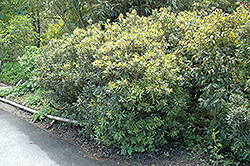Johnson Brothers Plant Finder
Height: 15 feet
Spread: 10 feet
Sunlight:
![]()
![]()
Hardiness Zone: 8b
Other Names: Cornish Pepper Leaf, Tasmannia lanceolata
Description:
Showy pale pink male flowers and lovely white female flowers bloom in mid spring; a striking hedge or shrub border when regularily pruned; magnolia like leaves and richly red young stems add interest; protect from cold wind
Ornamental Features
Mountain Pepper features showy clusters of fragrant pink star-shaped flowers with white overtones at the ends of the branches from mid to late spring. It has attractive light green evergreen foliage which emerges antique red in spring. The glossy oval leaves are highly ornamental and remain light green throughout the winter. The brown bark and dark red branches are extremely showy and add significant winter interest.
Landscape Attributes
Mountain Pepper is an open multi-stemmed evergreen tree with an upright spreading habit of growth. Its relatively fine texture sets it apart from other landscape plants with less refined foliage.
This is a relatively low maintenance tree, and should only be pruned after flowering to avoid removing any of the current season's flowers. It has no significant negative characteristics.
Mountain Pepper is recommended for the following landscape applications;
- Accent
- Mass Planting
- General Garden Use
Planting & Growing
Mountain Pepper will grow to be about 15 feet tall at maturity, with a spread of 10 feet. It has a low canopy with a typical clearance of 2 feet from the ground, and is suitable for planting under power lines. It grows at a slow rate, and under ideal conditions can be expected to live for 40 years or more.
This tree does best in full sun to partial shade. It does best in average to evenly moist conditions, but will not tolerate standing water. It is not particular as to soil pH, but grows best in rich soils. It is somewhat tolerant of urban pollution, and will benefit from being planted in a relatively sheltered location. Consider applying a thick mulch around the root zone in both summer and winter to conserve soil moisture and protect it in exposed locations or colder microclimates. This species is not originally from North America.


